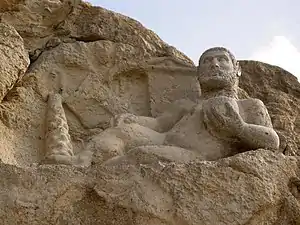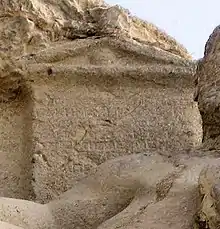
The Statue of Hercules in Behistun (or Statue of Heracles/Herakles in Bisotun, Persian: تندیس هرکول) is located on Mount Behistun, Iran. It was discovered in 1958,[1] and is the only extant rock sculpture from the period of Seleucid control over the Iranian Plateau, that lasted from c. 312 BC to c. 140/139 BC.[2]
The statue was sculpted in 148 BC, and dedicated in the name of "Herakles Kallinikos" (Ἡρακλῆν Καλλίνικον, "Hercules glorious in victory") by a Seleucid governor.[1][3][4] The Seleucid governor carved it in honor of a satrap.[2]
Hercules is lying on a 2 m long platform and holds a bowl in his left hand. His right hand rests on his leg. The statue is 1.47 m long and is attached to the mountain.[5] Heracles's club is carved in relief "as if propped up behind him" according to Matthew P. Canepa.[2] The form of the stele bears similarities to Seleucid stelae that bore official inscriptions in the area, most notably the stele from Laodicia-in-Media (Nahavand), on which a local Seleucid official wrote down a copy of the dynastic cult inscription of Seleucid ruler Antiochus III the Great (r. 222–187 BC), which he had created for his wife Queen Laodice III.[2] The head of the statue was stolen twice, but was recovered in 1996. The current head is a replica. The original head is held by the Cultural Heritage, Handcrafts and Tourism Organization.
Description
The Bisotun Hercules was carved by a sculptor who was not formally trained in the Greek sculptural style.[6] According to the modern historian Rolf Strootman, the design was more Iranian than Greek. In Hellenistic art, Heracles is seldom shown wielding a bow. In the rock relief, however, he is wielding a bow resembling those shown in the Behistun inscription.[7] Although the epithet of the god ("kallinikos") was quite common in the Greek religion, it was also appropriate for the Iranian god Wahrām (Avestan Vərəθraγna-), with whom Hercules was assimilated.[6] The statue of Hercules at Bisotun most likely attests to assimilation of the Greek god Hercules with the Iranian god Wahrām in the Seleucid period; however, it does not offer unequivocal evidence.[8]
The relief may have been part of a naiskos (small shrine), as indicated by the nearby remnant of a small Ionic column, which is the same height (52 cm) as that of the Temple of Athena Nike in Athens.[6]
Inscriptions
Behind the statue is a Greek inscription. An Aramaic version, drawn "quite a bit lighter" than the Greek version, is thought to have been carved below it, although only the word šnt ("in the year") is discernible.[9][10] Canepa notes that this indicates that the sponsor of the inscription "intended to situate this message, both visually and linguistically, within the idiom of Seleucid imperial epigraphy".[2]
| Translation | Inscription (original Greek script) | Original inscription |
|---|---|---|
|
|
 Herakles inscription at Behistun |
References
- 1 2 "Behistun, other monuments". Livius.org. Retrieved 10 October 2020.
- 1 2 3 4 5 Canepa 2018, p. 61.
- ↑ Visscher, Marijn S. (2020). Beyond Alexandria: Literature and Empire in the Seleucid World. Oxford University Press. p. 75, note 26. ISBN 978-0-19-005908-8.
- ↑ Frye, Richard Nelson (1984). The History of Ancient Iran. p. 230. ISBN 978-3-406-09397-5.
- ↑ Kasinec, Wendy F.; Polushin, Michael A. Expanding Empires: Cultural Interaction and Exchange in World Societies from Ancient to Early Modern Times. Rowman & Littlefield. p. 52. ISBN 978-0-8420-2731-1.
- 1 2 3 Canepa 2018, p. 185.
- ↑ Strootman 2020, p. 212.
- ↑ Canepa 2018, p. 180.
- ↑ "Bīsotūn Dedication to Heracles Callinicus". iranohellenica.eie.gr. 5 June 1976. Retrieved 29 December 2023.
- ↑ Bivar, David; British Institute of Persian Studies (1978). "The Aramaic Summary". In Stronach, David (ed.). Pasargadae: A Report on the Excavations Conducted by the British Institute of Persian Studies from 1961 to 1963. Clarendon Press. p. 161. ISBN 978-0-19-813190-8. Retrieved 29 December 2023.
- ↑ HIB Greek text – Parthian Sources Online.
Sources
- Canepa, Matthew (2018). The Iranian Expanse: Transforming Royal Identity Through Architecture, Landscape, and the Built Environment, 550 BCE–642 CE. Oakland: University of California Press. ISBN 978-0-520-37920-6.
- Strootman, Rolf (2020). "Hellenism and Persianism in Iran". Dabir. 7: 201–227. doi:10.1163/29497833-00701016. hdl:1874/408015.